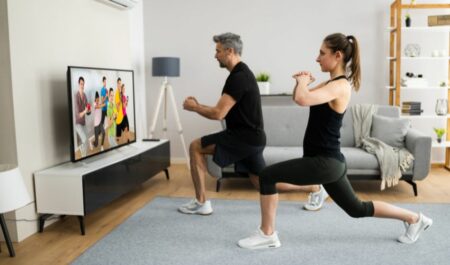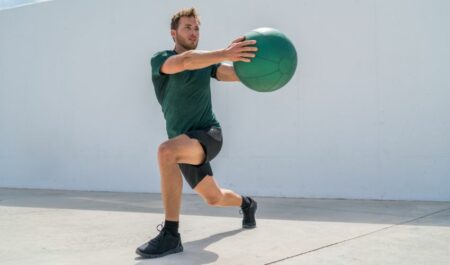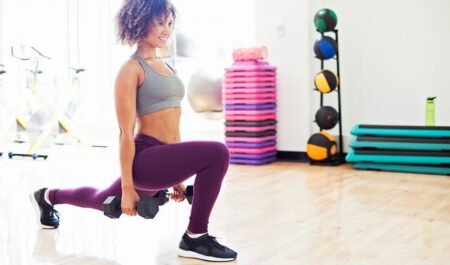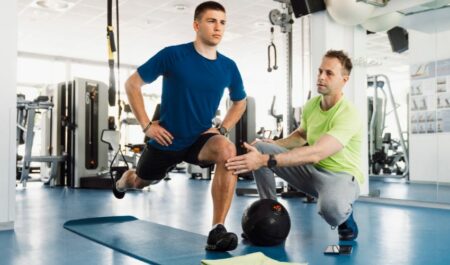The exercise known as the static lunge has a moving counterpart known as the walking lunge. When executing a dynamic bodyweight lunge, rather of returning to an upright position after completing a lunge on one leg, as you would when performing a static bodyweight lunge, you “walk” forward by performing a lunge on the other leg. The motion is carried out for a predetermined number of repetitions. So, you can learn, what is walking lunges exercise with complete guidance of it.
Walking lunges are great for building leg strength in addition to strengthening the core, hips, and glutes. Adding weights to your body or twisting your torso while performing walking lunges are two more ways to increase the difficulty of this exercise.
Continue reading to discover more about the advantages of walking lunges and the steps you need to take to include them in your exercise program.

Instructions For How To Do Walking Lunge.
- Maintain an upright stance with your feet at about shoulder-width apart. Your hands might rest on your hips or you can keep them at the side of your body.
- Take one step forward with your right leg and put your weight on the heel of that foot.
- As you go into a lunge position, bend your right knee and lower your body until your right thigh is parallel to the floor. Take a momentary pause here.
- Move your left foot forward while maintaining the same action on your right leg, and then repeat the process with your left leg. During the lunge position, pausing when your left leg is parallel to the floor is an appropriate break.
- Repeat this movement, “walking” forward while lunging and switching between your left and right leg.
- Perform ten to twelve repetitions on each leg. Perform between two and three sets.
Variations To Experiment With.
Combination Of A Walking Lunge And A Torso Twist.

It is necessary to have either a medicine ball or one free weight.
- Maintain an upright stance with your feet at around hip-width apart. Activate your abdominal muscles and bend your elbows to a 90-degree angle while holding a weight or medicine ball in front of your waist with both hands.
- Take one step forward with your right leg and put your weight on the heel of that foot.
- As your right foot strikes the floor and stabilizes, bend your right knee and lower yourself into a lunge position until your knee is parallel to the floor. Pause.
- After you have established a secure base in the lunge position, rotate your upper body to the right while keeping both hands on the weight. Your torso is where the movement should originate from.
- Turn your body so that you are facing the center again, and then begin to lunge forward with your left leg. Repeat the same motion on your left leg, this time “walking” forward while lunging and twisting to the left.
- Complete ten to twelve repetitions on each side.
Adding Weight To The Walking Lunge.

Two dumbbells are required as the necessary equipment.
- Maintain an upright posture with your shoulders pulled back. Maintain an erect position with your torso by holding one dumbbell in each hand and maintaining your arms at your sides.
- Maintain a calm position with your arms by your sides throughout the entire action. Put your weight on the heel of your right foot as you take a step forward with your right leg.
- As soon as your right foot stabilizes on the ground, bend your right knee and move into a lunge position by lowering your body down until it is parallel to the ground.
- Move your left foot forward while maintaining the same action on your right leg, and then repeat the process with your left leg. During the lunge position, pausing when your left leg is parallel to the floor is an appropriate break.
- Repeat this movement, “walking” forward while lunging and switching between your left and right leg.
- Perform ten to twelve repetitions on each leg. Perform between two and three sets.
Advice For Your Safety.
Walking lunges demand far higher levels of balance and coordination than their stationary counterparts. One of the most significant dangers is the possibility of sustaining injuries as a result of losing one’s equilibrium and falling. Incorrect form might also raise the likelihood of tearing a muscle in your body.
Lunges while walking are an exercise that can be performed by the vast majority of people without risk. If you are just starting out, it is recommended that you begin with a static lunge until you have the hang of the proper form. When performing walking lunges, it is essential to have proper form in order to assist reduce the risk of injury.
Be sure to keep these safety precautions in mind:
- Maintain a standing position with your body throughout the activity. Make an effort to avoid leaning forward an excessive amount.
- Maintain a strong engagement in your core for the entirety of the lunge.
- When you lunge forward, be sure you don’t put too much extension into your leg because this can cause your back to arch.
- You should attempt to step out as much as necessary so that your body can be vertically comfortable and your torso and hips can be in a straight line. Your knees are at risk of injury if you do not step out far enough, which can potentially lead to ailments in other parts of your body.
Working with a trainer, or a friend or family member who is familiar with walking lunges, might be helpful if you are new to exercising and want to get into shape. They may check that your form is right and provide you pointers that will help you get the most out of this maneuver by maximizing its potential.
What Are The Advantages Of Doing So?
Walking lunges are a great exercise for helping to build strength in the lower body. They also have the potential to assist in hamstring and gluteal stretching.
For optimal outcomes from your workout, include both static and walking lunges in your regimen.
Which Muscle Groups Are Getting A Workout?
The following muscles get a workout through walking lunges:
- Quadriceps.
- Glutes.
- Hamstrings.
- Calves.
- Abdominals.
- Hips.
The following is a list of other advantages that walking lunges offer.
Attempt To Increase Your Range Of Motion.
Walking lunges are a great way to improve your flexibility and relax up your hips and hamstrings, which can help you achieve a greater range of motion in your joints. This has the potential to assist in the improvement of posture and balance, which can be advantageous to athletes, casual exercisers, and beginners who are just starting out in the fitness world.
Improved Operational Capabilities.
Functional movement training includes activities such as walking lunges. They imitate motions that you perform on a daily basis, such as standing up, sitting down, and advancing one step forward to pick something up off the ground. Regularly practicing walking lunges can help make these types of common movements easier to do in the real world.
You Should Incorporate Walking Lunges Into Your Workout Program.

Including walking lunges twice or three times per week in your regular workout regimen is a good idea if your goals are to increase your overall level of physical fitness and build up the strength in your legs.
If you are just getting started with working out, you should begin by performing 10 to 12 walking lunges at a time. Try out some other lunge variations as well, such as leaping lunges or lunges combined with bicep curls, if your objective is to get rid of excess weight or tone your body.
In addition, you should perform cardiovascular exercise or high-intensity interval training two to three times a week, alternating such workouts with strength training exercises such as lunges on the days in between.
Consider working with a certified personal trainer who can create an exercise routine for you to follow, or look for a routine online if you don’t know how to set up an exercise routine on your own. Both of these options are available to you if you don’t know how to set up an exercise routine on your own.
The Bottom Line
Walking lunges are an effective functional exercise for strengthening the lower body since they need the body to move. Include them in your training program a few times per week to improve the strength of your legs, hips, glutes, and abdominal muscles, among other muscle groups.
If you have never exercised before, you should start by learning how to perform a static lunge. When you feel comfortable with the technique, you can go to walking lunges. If you are unsure whether or not you are performing the action correctly, it is recommended that you seek the assistance of a qualified personal trainer.
FAQs
Are Lunges The Same As Walking Lunges?
Walking lunges place a greater emphasis on the front leg since they require the walkers to rise forward while maintaining their lunge position. On the other hand, when you perform stationary lunges, the emphasis is placed more on the back leg as you return to the beginning position. Stability is essential for walking lunges, which call for greater support than standard lunges.
Why Are Walking Lunges So Hard?
The gluteus maximus is actually the major mover during lunges, despite the common misconception that this exercise targets the quadriceps. Your hamstrings, calves, hip stabilizers, and adductors (the muscles on the inside of your thighs) all get a little bit of attention from this exercise. Additionally, your core muscles, in particular your obliques and your deep lower back, get a good workout.
Is Walking Lunges Muscular Endurance?
Walking lunges can be the ideal technique to give your spine some much-needed relief if you often engage in strenuous exercise and weight lifting. Take note that the walking lunge is one of the most effective exercises for athletes. It enhances both the endurance of the legs as well as the overall strength of the lower limbs and the firing pattern of the glutes and hamstrings.
What Are The Benefits Of A Walking Lunge?
Walking lunges are a great way to improve your flexibility and relax up your hips and hamstrings, which can help you achieve a greater range of motion in your joints. This has the potential to assist in the improvement of posture and balance, which can be advantageous to athletes, casual exercisers, and beginners who are just starting out in the fitness world.
What Type Of Exercise Is Walking Lunges?
Walking lunges are an excellent exercise for the legs. All of the muscles in your legs, including your quadriceps, hamstrings, and calves, will get a workout with this exercise.
Are Walking Lunges Better Than Stationary Lunges?
Walking lunges are an excellent way to tone the lower body in a balanced way. In addition to that, it counts toward cardio. It improves both your balance and posture, which in turn enables you to complete other exercises using your own body weight more effectively. Walking lunges are the most effective way to acquire a perfectly shaped butt, however static lunges can also assist tone the glutes.
